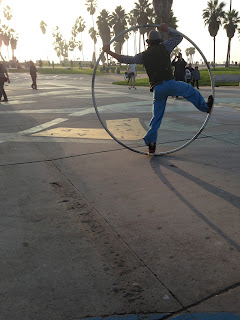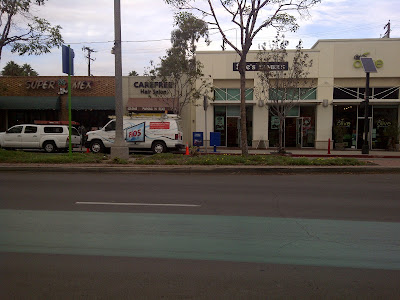This week I decided to visit the city of Venice. Venice turned out to be a very lively city with so much recreation and so many activities going on. I explored the boardwalk area, as well as the nearby neighboring streets.
As I was walking through the boardwalk, I noticed there were a lot of small businesses that surrounded this area. Entrepreneurship is a really common thing in the Venice boardwalk, with vendors selling tourist clothing, food, body artwork, and there were also many shops with smoking tools. There were also many people who created their own artwork or crafts that would have their own stand of their creations to sell and make a living from. Their artwork looked genuine and some people were very talented. I also saw many musicians and people using their talent to receive money from people walking around and looking for entertainment. Around this area there were also many sites made for recreation. There were small tennis courts, an outdoor gym also known as the site for "muscle beach," there was a skating area, and also basketball courts. This was a very lively area where people simply came together to enjoy entertainment, outdoor recreational activities, or even just to take a walk near the beach. The area was very accepting of differences and the many talents that people had. I saw many of the people who came to show their talents for a living bonding with each other, possibly because they understood each others struggles. There were also news reporters all around and there also seemed to be a shooting of something. Entertainment in Venice is a common thing. Venice was also full of murals and artwork on many of the buildings, it brought life and color to the boardwalk.

Besides the active and lively atmosphere that Venice had, it also appeared a little corrupted for the amount of tourists that it had. This is a very pretty and unique place to visit, however, there were many homeless people, individuals just standing around begging for money, or people offering medical cards so that people could purchase marijuana legally. This area was especially dominated by the promotion of marijuana, with many smoke shops selling glass pieces for such use. Many of the stores sold clothing, posters, and signs with the marijuana symbol on them. The police was consistently passing by on the boardwalk throughout my visit and at some point I even heard a man who appeared to be homeless verbally abuse the police woman.
I have not visited Venice in two years, and this time around there seemed to be a lot of homeless people on the boardwalk. Last time I visited, it was definitely something I had not noticed, but during this visit, there were so many and they associated with each other. There were even boxes around that said homeless people, I am guessing that they had items that only pertained to the homeless people. I bring this point up because my Los Angeles Times article has to do with Venice and the issue of homeless people, Venice residents and overnight parking.
http://www.latimes.com/news/local/la-me-venice-parking24-2009feb24,0,424364.story
In this article many of the Venice residents are upset of the fact that there are so many homeless people living in cars and RV's crowding the streets, so they voted to pass parking restrictions where overnight parking would be band from some of these areas of Venice. As I walked around and visited the site, I didn't see any RV's only "NO PARKING" signs that surrounded the area. I don't think this issue has anything to do with the amount of homeless people in the boardwalk itself, but homelessness has become an issue in Venice. I think this area is so pretty, lively, and great to visit, however, it does become a strange place to visit when you have homeless people that are verbally abusing police men or just even lingering around such a beautiful area.
This also was my bus trip. On my bus ride, I mainly just observed the Santa Monica area, because that is the area in which the Big Blue Bus drives through. It was very commercialized and full of businesses all around. The many people that took the bus were either students, or families that had no other source of transportation or simply people trying to get to work. Overall it wasn't that bad of a ride. I think the Big Blue Bus is one of the most enjoyable bus rides to take because the area in which it drives through is so touristy and full of curious businesses that make you want to visit and check out.
Overall, I enjoyed my visit to Venice and my ride on the Big Blue Bus, next time I might just support one of the vendors and buy a painting because they have some amazing talent!







































